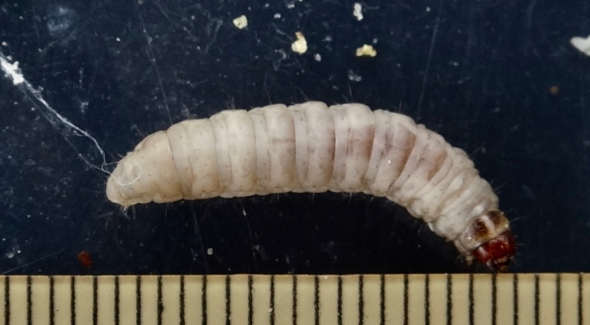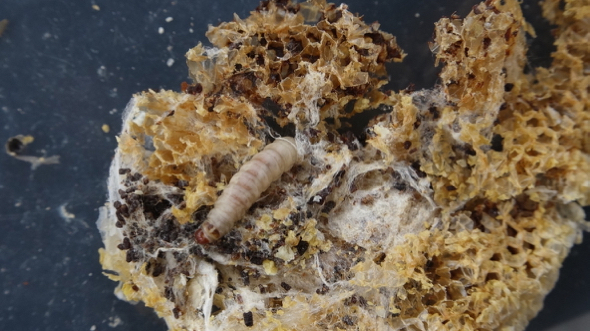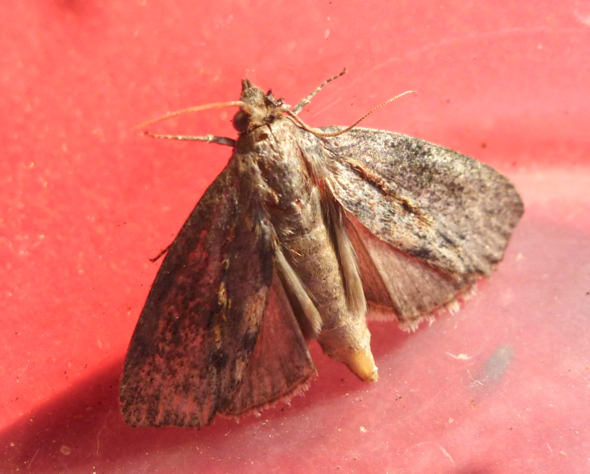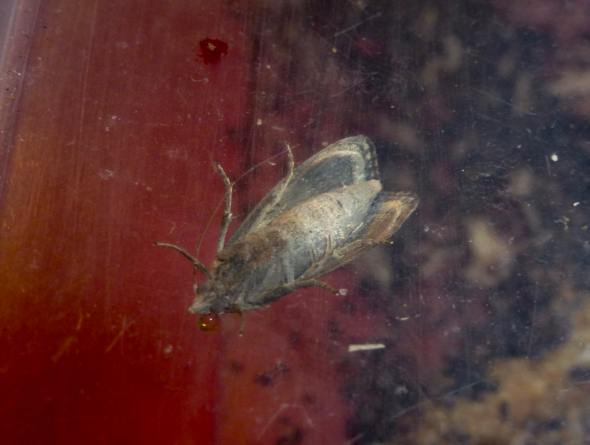Dwarf Honey Bee: 1. Colony; 2. What happens when it rains?”; 3. Bees have absconded; 4. A piece of damaged comb.

A white larva of about 20 mm long (above) was seen on the pieces of comb salvaged from the Dwarf Honey Bee (Apis andreniformi) colony where the bees had absconded LINK.

Within a few days, more such large larvae were seen moving in and out of the comb piece (above, video clip below).
A chance encounter of an image on page 174, fig. 193 of Koeniger et al. (2010), provided a lead to the identification of these larvae as those of a wax moth.

This was further confirmed when the container where the pieces of comb were kept had a small moth trapped inside (above, below). The many black pellets scattered on the white comb pieces were obviously faeces of the wax moth larvae.

On examining the underside of the container, a single larva can clearly be seen among many pupae embedded in the wax of the comb pieces (below).

It would appear that wax moths regularly infest honey bee colonies causing the bees to abscond. According to Koeniger et al. (2010), the larvae burrow through the comb causing damage to it and feeding on the honey, pollen and the cast skin of bee larvae. These wax moth larvae then spin white cocoons to protect themselves from the bees during the pupa stage.

Nearly a dozen wax moths subsequently emerged from the pupae within the next few days (above, below). These helped in the identification of the species.

There are two species of wax moths: Lesser Wax Moth (Achroia grisella) and Greater Wax Moth (Galleria mellonella). Based on the literature, the Lesser Wax Moth has a distinct yellow head but not the Greater Wax Moth. As the wax moth collected from the comb specimen has no yellow head, the tentative identification of the wax moth parasitising the Dwarf Honey Bee colony is the Greater Wax Moth.

Obviously the invasion of the Greater Wax Moths caused the Dwarf Honey Bees to abscond from the colony.
Latest: On the evening of 5th November 2018, a new colony was sighted in the same tree and near the old nesting site – roughly a month after the bees absconded.
YC Wee
Singapore
27th October 2018
Reference:
Koeniger, N., G. Koeniger & S. Tingek (2010). Honey bees of Borneo: Exploring the centre of Apis diversity. National History Publications (Borneo), Kota Kinabalu. 262 pp.









2 Responses
i wonder what ecological function is served by wax moths in disrupting bee colonies ?
Wax moth larvae feed on the honeycomb… this is where they breed… with ready food for the larvae when they hatch from the eggs. Disruption of the bee colony is just a consequence…